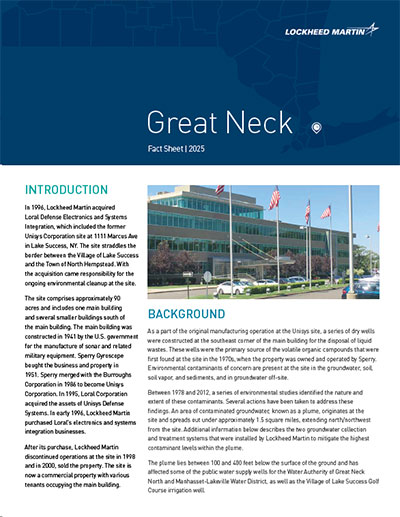Site Overview
The former Unisys Great Neck site spans approximately 90.5 acres, located at the border of Lake Success and North Hempstead, NY. It features one main building and several smaller structures to the south.
History
The U.S. government established the site in 1941 for electronics and systems integration operations, supporting the World War II effort. Sperry Corporation bought the business and property in 1951 and continued operations. Through mergers and acquisitions, the site changed ownership until Lockheed Martin acquired the company in 1996. Operations were discontinued in 1998, and the property was sold in 2000. Lockheed Martin has assumed the responsibility for the cleanup of the former Unisys Site.
The New York State Department of Environmental Conservation (NYSDEC) designated the site as a Class 2 hazardous waste site in 1991, outlining necessary remediation goals. Multiple studies have been conducted to identify the contaminants in groundwater, soil, soil vapor, and sediment resulting from historical manufacturing operations at the former Unisys site. A series of dry wells, no longer in use, was identified as the primary source of subsurface contamination.
Remediation
Remediation efforts have included both on-site and off-site cleanup actions:
On-Site Cleanup
- Groundwater Treatment: A groundwater treatment system was installed in 1993, evolving into a state-of-the-art system in 2001-2002. The system was upgraded in 2018, increasing the flow from 730 gpm to 850 gpm.
- Soil and Sediment Management: Soil cleanup began in 1994, involving the removal of contaminated soil and installation of a vapor extraction system. In recent years, additional excavations have addressed buried contamination. Sediment contamination in stormwater basins has been managed with access restrictions.
- Soil Vapor Intrusion Mitigation: A building-wide sub-slab depressurization system was installed in 2008 to prevent soil vapor intrusion into the main building, with an additional system installed in the northwest corner of the athletic facility in 2018. The systems are continuously operated and monitored to ensure the vacuum is constantly maintained under the buildings.
Off-Site Cleanup
To clean up contaminated water that had already moved off-site, Lockheed Martin constructed a second groundwater treatment system (Operable Unit-2, OU-2) off-site in June 2004. Lockheed Martin is also providing funding to protect the public water supply in the wider area, working with the local water purveyors. Continuous monitoring and treatment systems are in place to ensure the safety and quality of drinking water in the surrounding areas.
Documents for the Great Neck Project Are Available in Public Repositories at:
Hillside Public Library
155 Lakeville Road
New Hyde Park, NY 11040
516.355.7850
Great Neck Public Library
159 Bayview Avenue
Great Neck, NY 11023
516.466.8055
Resources
If you have questions, please contact Lockheed Martin Communications.
lm.communications@lmco.com
800.449.4486
Documents and reports related to the Great Neck site are publicly available from the NYSDEC Document Archive
Great Neck Site Archive (no longer updated)




